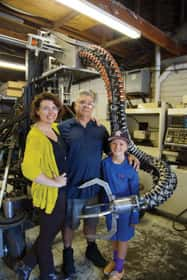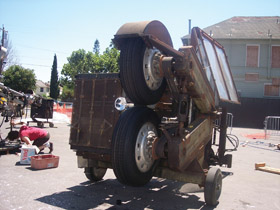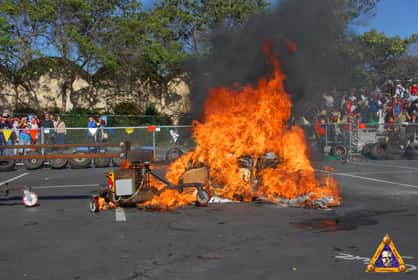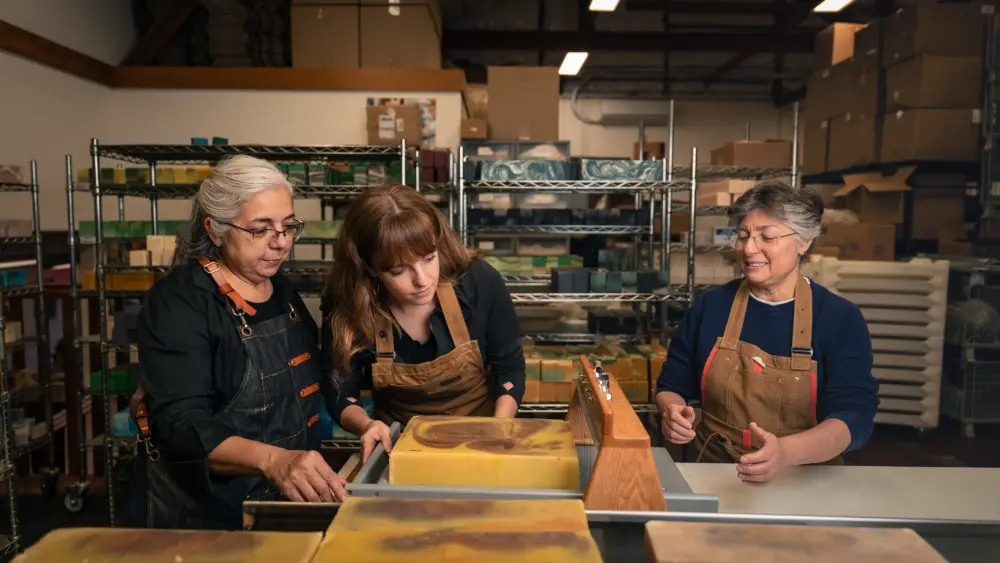Founder of Survival Research Labs, Mark Pauline creates mechanized art and spectacle.
 Petaluma artist and entrepreneur Mark Pauline isn’t your average guy.
Petaluma artist and entrepreneur Mark Pauline isn’t your average guy.He has toes instead of fingers on his right hand. He sells computer motherboards to the Israeli military. And when he gives a speech in San Francisco, the fire department arrives to escort him away.
What pushes Pauline into the realm of extraordinary, however, is that he’s a mechanical genius—a sorcerer who seems to breathe life into inanimate objects.
Pauline is founder and creative director of Survival Research Labs (SRL), most famous for staging self-described “dangerous and disturbing mechanized presentations” that feature hand-built machines, loud noises and lots of smoke. Less well known is Pauline’s role as a consultant in the asset management business, where he buys and resells surplus equipment and technologies.
Pauline fell in love with machines at age nine, when a teacher stood him in front of a band-saw and told him to make a bowl out of a block of maple. Today, he operates everything from old-school welders and table saws to modern computer numerical coding (CNC) machines and 3-D modeling software to build unconventional contraptions with their own story—like the forklift-powered robot with a serpent-like spine made from military-grade synthetic cable and 700 hand-crafted titanium bushings, the military propulsion device designed to launch concrete-filled beer cans with explosive tips, or the Boeing jet engine jerry-rigged as a flamethrower.
“I specialize in finding value from technology other people have discarded,” says Pauline. “One of these days, the machines are going to be discarding us. I look forward to that day, because I’m prepared for it.”
Behind the iron(ic) mask
Pauline grew up in Florida in the 1960s, one of four boysraised by a single working mother. Unsupervised most of the time, he hunted snakes, shot guns and battled with his three older brothers. It was a rough and tumble childhood—an early, hands-on education in how to take risks without getting seriously injured or landing in jail.
By junior high school, Pauline had noticed two important qualities about his personality. First, he enjoyed making things with big and dangerous machines, like the band-saw he’d learned how to use in woodshop class. Second, he’d sit stone-faced during a television sitcom yet laugh when someone tripped in front of him.
“My sense of humor has always been kind of acerbic and leaning toward the grim,” says Pauline. “I figured that out when I was about 10, when my mom explained the concept of black humor and hard irony to me.”
Pauline cultivated his interest in machines by taking high school classes in drafting and shop, where he learned skills like welding and machine tooling, and, after high school, through jobs building tractor trailers and military target robots. He nurtured his artistic sensibilities by leaving the factory and going to college, where he studiedtheater.
In 1978, when Pauline was 25 and living in San Francisco, he discovered how to combine both passions.
“I decided to create theatrical pieces with machines, not people, as the main characters,” he explains. “I figured I could go all over the world and bring my machines.”
Since then, Pauline has staged more than 50 showsfeaturing dozens of mechanical characters he’s built by himself or with the scientists, engineers and programmers who comprise the SRL team. Most of his machines incorporate different hardware parts that Pauline has either salvaged from a factory-built machine or fabricated in his workshop. Also embedded are computing and communications technology—such as Wi-Fi and remote control—that enable the machines to be operated from hundreds of yards (or even thousands of miles) away.
Transforming an idea in Pauline’s head into a fully operating machine requires mechanical engineering skills—and patience. Pauline considers himself an excellent troubleshooter, a “machine whisperer” of sorts who can look at a machine and intuit what’s wrong with it. His skill comes from years of hands-on experience but also from a philosophical perspective that treats machines as if they’re alive.
“Any good troubleshooter will respect the problem, even if it deals with inanimate technologies,” he says. “It’s not helpful to dismiss something as just a dumb machine. You have to characterize it.”
 SRL machines are massive and mutant-looking; even motionless in Pauline’s warehouse, they seem intimidating. Still, Pauline says, SRL machines cannot carry the show because, like all machines, they’re too limited in their abilities and predictable in their actions. To plunge his audience into a mechanical dreamscape, he adds disconcerting sounds, uncomfortable physical sensations and disturbing images.
SRL machines are massive and mutant-looking; even motionless in Pauline’s warehouse, they seem intimidating. Still, Pauline says, SRL machines cannot carry the show because, like all machines, they’re too limited in their abilities and predictable in their actions. To plunge his audience into a mechanical dreamscape, he adds disconcerting sounds, uncomfortable physical sensations and disturbing images.“I always do the most extreme thing possible,” says Pauline. “The messages in an SRL show are always harsh, and the action is as intense as possible within the bounds of physics and safety.”
Stirring up controversy…and loyalty
Not everyone appreciates this level of intensity. After an audience member suffered a minor injury from burning debris blown by high winds at an SRL show at the 2003 Maker Faire, all of Pauline’s machines were confiscated by the San Mateo County Sherriff’s department, and he was required to pay a fine to recover them; SRL is now banned from staging any further events at Maker Faire. SRL is also too hot for Burning Man, which prohibits the use of projectiles and diesel fuel flamethrowers and is too much like Disneyland in its rules and regulations, says Pauline. And, in 1995, after incurring the wrath of the fire department in San Francisco, Pauline was banned from staging an SRL show in California for an entire year.
 Pauline knows well the dangers of his art. He seriously injured his right hand while mixing two types of fuel, and only regained its use after experimental surgery replaced the lost digits with two of his toes. Today, for the safety of everyone involved, he takes extra precautions not only in staging the show but also in manufacturing SRL machines. For example, his team uses CNC fabrication machines instead of more dangerous industrial tools, and everyone rehearses a show multiple times before it’s staged.
Pauline knows well the dangers of his art. He seriously injured his right hand while mixing two types of fuel, and only regained its use after experimental surgery replaced the lost digits with two of his toes. Today, for the safety of everyone involved, he takes extra precautions not only in staging the show but also in manufacturing SRL machines. For example, his team uses CNC fabrication machines instead of more dangerous industrial tools, and everyone rehearses a show multiple times before it’s staged.
“Some people get nervous because Mark’s machines can’t be categorized and are one-of-a-kind,” says Karen Marcelo, who’s been involved with SRL since 1995. “There aren’t specific rules against them, but they look like they shouldn’t be allowed.”
 Pauline knows well the dangers of his art. He seriously injured his right hand while mixing two types of fuel, and only regained its use after experimental surgery replaced the lost digits with two of his toes. Today, for the safety of everyone involved, he takes extra precautions not only in staging the show but also in manufacturing SRL machines. For example, his team uses CNC fabrication machines instead of more dangerous industrial tools, and everyone rehearses a show multiple times before it’s staged.
Pauline knows well the dangers of his art. He seriously injured his right hand while mixing two types of fuel, and only regained its use after experimental surgery replaced the lost digits with two of his toes. Today, for the safety of everyone involved, he takes extra precautions not only in staging the show but also in manufacturing SRL machines. For example, his team uses CNC fabrication machines instead of more dangerous industrial tools, and everyone rehearses a show multiple times before it’s staged.“We’re primed to prevent accidents and, if they occur, stop them from getting worse,” says Pauline. “I don’t need to hurt people to get my message across.”
SRL has staged shows at local venues, including Petaluma’s Rivertown Revival and the Sonoma County Museum in Santa Rosa, with no negative consequences. “Attendees loved the SRL show at the 2010 Rivertown Revival,” says Kelin Backman of Clementine Eco-Events. “Mark is a straight shooter in a good and helpful way. I really enjoyed working with him.”
Marcelo agrees, praising Pauline for his artistic integrity and ability to create a level playing field for women in what’s traditionally been a male-dominated realm. “SRL was, and continues to be, the only place where you can play with the latest technologies and subvert them to other than their intended purpose, safely blow things up and be encouraged to do that in a responsible, experimental way,” she says. “In the process, you break a record, invent something, or at least just learn something.”
The abandoned equipment savior
A guiding principle of SRL has always been Pauline’s desire to mine the “use value” of machines and technologies. Pauline likes to put an ironic twist on this concept in his art—transforming a police robot designed to defuse bombs, for example, into a tool for setting off explosions. However, he takes a different tack in his work as a consultant and reseller in the asset management business, helping equipment that outlived its usefulness in one company to find an extended life in a new setting.
Pauline entered this business in the 1990s as a way to simultaneously pay off his debts and clean out his warehouse. SRL friends from the San Francisco Exploratorium had started one of the first asset management companies (HMR USA), and he often searched through their warehouses to find odds and ends for his shows. At first, HMR simply took equipment from its clients and salvaged them for raw materials. But, within a few years, Pauline noticed a higher quality of equipment coming in. He recognized he could buy usable equipment from HMR, then sell it for a small profit.
The asset management industry has grown tremendously in the ensuing years, in part because of increased environmental awareness and recycling laws. But the concept is still the same. On one side of this market are large corporations and government agencies that need to move unused equipment out of their facilities and off their books. On the other side are organizations that need equipment but can’t afford to pay full price. Connecting the two are asset management companies and independents like Pauline.
Pauline has carved out a niche trading in what he describes as “hard-core, crazy” equipment within a few vertical markets, like health care and telecom. He buys this equipment from asset managers who don’t want to deal in the low quantities he prefers, or directly from smaller companies upgrading their infrastructure or going out of business. Then he sells the equipment via online exchanges like eBay and Craigslist.
As with his shows, Pauline has earned a reputation for being extreme, but in a good way. Asset managers know that if they get an arcane piece of equipment in, Pauline will likely know what it is and, if he’s interested, pay cash for it on the spot. Customers appreciate the fact that he only sells equipment that works, and that he packs it professionally to ensure a safe arrival—no small feat when you’re dealing with sensitive microscopes or chest-high machines.
“I score 100 percent perfect on customer reviews,” says Pauline, who put a framed certificate of appreciation from eBay in his office. “Most of my business comes from repeat customers.”
Pauline has spent tens of thousands of hours tinkering with machines, reading manuals for fun and reverse-engineering anything that didn’t come with instructions. He also has an uncanny ability to remember part numbers. As a result, he can look at an unfamiliar machine, identify it, determine who needs it and assess its value. His talents not only enable him to stay in business, they also help him prevent machines from falling into what he calls “the beige box syndrome.”
“Once a piece of equipment is removed from its lab or workshop, it becomes nothing more than a beige box,” he explains. “No one knows what it is or what to do with it.”
Examples of these mysterious machines are tucked into various corners of Pauline’s main workshop. A nondescript black box is actually a network simulator worth $10,000 new; Pauline will list it for $900 and expects to sell it in a few weeks. A strange microscope mounted on a headpiece is meant for an optometrist’s office, not a warehouse; Pauline bought it from a medical college that went bankrupt. The wafer-thin sheets of black plastic are real-time computers the military puts in its testing equipment; Pauline sells these to a handful of agents who purchase them for Israel, France, Germany and the United States.
“It’s a weird, opaque market,” admits Pauline. “I don’t even want to think about where these end up.”
To succeed in this unconventional business, Pauline has to operate like any other 21st century entrepreneur. He nurtures a global customer base to protect himself from regional economic turmoil, and he’s learned how to analyze customer behavior to predict the next boom—or bust.
“My customers are the engines of their regional economies,” explains Pauline. “When they stop buying equipment from me, I know an economy is starting to stall.”
Pauline also knows how to leverage the SRL brand. His shows appeal to a wide network of tech and engineering professionals. They often share insider information about tech assets about to be liquidated. And sometimes, they end up as paying customers.
“People see our shows live or on YouTube, and they want to connect,” says Pauline. “It’s a huge boost for sales. They can tell their friends, ‘I bought something from SRL.’”
Dangerous and Disturbing Machines
The Pitching Machine: A 20-foot long contraption with two high-speed truck tires and a 500-cubic-inch engine. It has the ability to discharge six-foot-long, two-by-four-inch boards of wood at a velocity of 200 miles per hour with a calculated range of 800 feet.
The Running Machine: This is a six-legged, remote-controlled machine powered by a small gas engine, a Vickers piston pump and a wicked-looking chain drive. A moving, articulated arm on the front carries interchangeable parts (like a stabbing knife and cutting tools).
The Hand-O’-God: The Hand-O’-God is a giant, spring-loaded hand cocked by a hydraulic cylinder with eight tons of pressure. It can be attached to a remote-controlled bomb loader.
An Extraordinary Partner
When Mark Pauline needs help solving a creative or logistical challenge, he often brainstorms with his eclectic and resourceful wife, executive producer Amy Critchett.
Critchett likes to say she makes the impossible happen, and there’s no better example of this personal credo than her production of The Bay Lights, a contemporary art experience designed by renowned light artist Leo Villareal that features 25,000 individually programmed white LED lights on the west span of San Francisco’s Bay Bridge. Critchett signed onto this project in 2011, when it was just an idea. Since then, she managed the teams and has overseen the many details that needed attention, from lobbying politicians to raising money to pulling permits to climbing onto the Bay Bridge to bring this spectacular public art to millions of people every day.
“I put fabulous, smart people into unexpected situations and celebrate their results,” says Critchett. “My goal is to create evocative experiences that inspire and activate the world around me and beyond.”
Critchett’s ability to work with people—and move mountains in the process—no doubt arises from her experience as the daughter (and campaign strategist) of former North Bay Congresswoman Lynn Woolsey. Another important trait she inherited from her mother is fearlessness. Case in point: Critchett’s return to competitive artistic roller skating, a sport she excelled in as a child and teen.
“I was raised by an audacious mother who taught me to believe in myself and to do whatever I can to feed my soul,” says Critchett. “So here I am, at age 47, training four times a week with hopes of qualifying to represent California at the National Artistic Rollerskating championships.” [Editor’s note: Critchett has since placed fourth at the national finals.]



